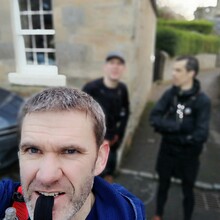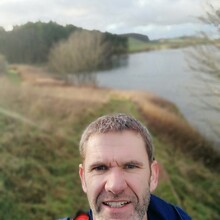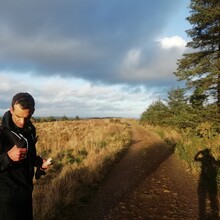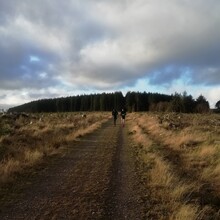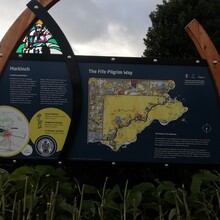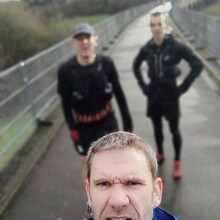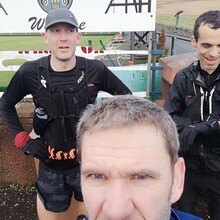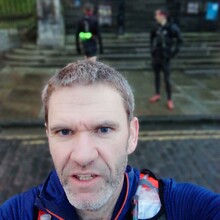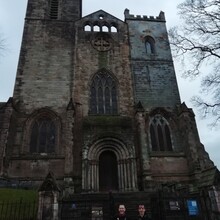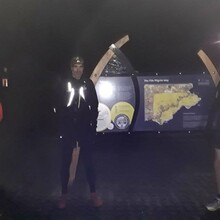Full run report
In a time when races are virtual, fastest known times have taken on a bit more meaning. What to do though when you're in Scotland's level 3 lockdown, heading into level 4 and live in, and have to keep to, Fife? The Fife Coastal Path is frankly too long to be attractive at a time of year when we have so little light and I'm happy to leave the Four Fifers to James Crozier and Scott Strachan to fight out. However, to my surprise it seems that no one had done the complete Fife Pilgrim Way in one day, far less registered an FKT.
I was supposed to be running GO33 (Glen Ogle Ultra) this year, but it just kept getting postponed and staying fit for such a long race for month after month just wasn't sustainable. So, what to do with that fitness? Cue a fit of overenthusiastic challenge setting and the idea of doing the FPW in one, on the shortest day. 90k should be doable in 9 hours right? That’s an easy average pace of 6 min/km, which basically takes you from dawn to dusk plus a little bit of nautical twilight on either side.
Though we never really built the kind of endurance that allows seasoned ultra runners to keep pushing right through to the end of a route, we were as ready as we had ever been, with nothing else to target. The we in this case are James Hall, who had been accompanying me on most of my long runs for the last months and Olivier Penacchio, our Pyreneen superstar and Fife AC's best kept secret weapon (he just never races). Thankfully it was possible to have three runners, in a time of only two households mixing, by making the attempt a Fife AC group run (thanks go to Wendy Ritchie for being our official coach for the day). James and I recced all the sections we thought we needed to, such as all the fiddling about in Glenrothes. That started to give us fore-warning of what would be the biggest challenge, mud.
The shortest day is, of course, the 21st, not the 20th, but the day length is the same within a minute, so it makes no difference to the challenge. However, the forecast was much better for the 20th, so it won over. In the end we had a moderate tailwind, relatively mild conditions, a fewer showers early on and some sun in the second half. We set the start time as 07:25, giving us 9 hours until dusk. What we had less control over was the weather in the weeks (months) before. Such a lot of rain led to what seemed like unprecedented amounts of mud. The FPW is about 50k trail and 40k road/solid surface, but the overwhelming memories would be of the muddy sections of trail.
>Culross to Dunfermline> 0 km – 14 km
Setting off in Culross we had to negotiate what seems, at least to anyone planning to get to St Andrews that day, a somewhat cruel start. You have to head up, through what is I admit, a lovely village, on a pretty steep hill to get up to the Abbey, before instantly dropping down a grassy pend straight back down to the main road. The one advantage of that is it stops you obsessing about a good average pace right from the word "go". This section to Dunfermline was one of the two that we hadn't recced, and thankfully it was fairly straightforward, only once or twice pausing to be sure we had it right (and doing our best not to pause our watches out of habit). The trail sections were wet and muddy in places, but nothing too bad, especially if you have the energy to dance around the bad bits. We started with headtorches, but quickly packed them away and enjoyed running into the sunrise over the Firth of Forth. Dunfermline duly arrived after what felt like an easy stroll which slipped by with a lot of chat, seemingly no effort and keeping pretty to schedule.
>Dunfermline to Lochore> 14 km – 31 km
Photos were taken at the Abbey and we left about 2 minutes ahead of schedule. It’s a long drag out of Dunfermline, but least it was quiet in the town centre with shops only just opening up. A reminder of reality took the shape of the COVID drive-through testing centre just West of East End Park football stadium. The route takes you along the old railway here, where the first gels were eaten, so is dead flat until you head North past the hospital, out of Dunfermline and up the new cycle path to Kingseat. The chat was still flowing and the running fluid. From here you head down to Loch Fitty, across the causeway and on into St Ninians old open cast pit. The easy pace made what is a sizeable hill feel very easy indeed. The only hiccup was having to negotiate a group of horses plus riders. No problem, except that James and I both paused our watches out of habit. We now definitely had to post the run as a race to get a true time for the distance. Once out of St Ninians you head into Keltywood and this is a good place to have done a recce. The interactive maps online and the pdfs available have different routes, with the latter following the correct route, the former sticking to the access road. The rest of this section went by without any incident, though by the time we were approaching Lochore we did start to get an inkling of which places were going to hurt, even if they weren’t hurting just yet. Last time we ran the Lochore section we had a flyby from Kris Jones, Jamie Crowe and Ali Hay, no such luck this time. Surfaces up to this point were good, certainly no worse than you expect for trails in December. We came to the Meedies a couple of minutes ahead of schedule.
>Lochore to Leslie Viaduct (hallway)> 31 km to 45 km
If the trails had been ok to this point, any illusions that this might continue were very quickly shattered. The section of trail out of Lochore and up and round Hare Law was absolutely shocking. I’m sure the PH Racing boys would agree, as we passed them at one of the worst sections going in the opposite direction. Even once on the farm track this section continued to be very wet and muddy, already fatiguing all those smaller stabilising muscles and putting that bit more strain on everything. The closer we got to Woodend and the road, the better the track became. Woodend to Kinglassie is a bit of a weak link in the whole route, with the FPW simply following a pavement beside the road. It did make for some faster running. That’s all relative though and we were sticking to a little over 5 min/km. Kinglassie was the first place we thought we might stop to buy water. We had decided fairly late on that we didn’t want to carry all our water for 9 hours. Unsupported is great when you have access to clean mountain burns, not so good in rural, suburban and urban Fife. It felt like it might even be more artificial to go unsupported, but we wanted to keep it as “pure” as possible, so self-supported it was. We didn’t need more water yet though so only stopped for long enough at the miner’s club to take a photo before heading up the nasty hill. This is a section we knew, and we knew it would be bad. The mud and puddles above Kinglassie are bad, but only get worse as you head over to the River Leven past Flowers of May and Bloody Foots (love that name). A boost here was to pass through the marathon distance in a respectable 3:45 and despite the muddy challenges on the way to Leslie we managed to stick to our schedule and arrived at the viaduct over the Leven still 2 minutes ahead of schedule. The viaduct roughly marks half way and we had hoped to be there in 4 hours, knowing the second half was much more challenging and would be done on fatigued legs we wanted a fill hour extra for it.
>Leslie Viaduct to Kennoway> 45 km – 58 km
If you look at the map it seems innocuous enough, and having run it all before we weren’t worried about. The thing is, we’d never done it with a marathon already in our legs and it proved to be one of the hardest sections of all. The trail heads off into the trees along the Leven after the viaduct and the path is unrelenting in its undulations. It’s a good path, but never flat until you eventually drop down to the river. The drag back up from the river felt tough with the legs already starting to feel tired. However, we kept to target pace, enjoyed the trails through Balbirnie estate as much as we could and arrived in Markinch. This time we decided we would stop to top up our water supplies. Though all we needed was 0.5L of water each, we took forever to get the water and sort ourselves out. This stop alone took us over the 9 hour mark at the finish. In fact, we stopped long enough to really tighten up and getting going again was hard. The next section is great in a dry spell, but at this time of year it is 5 km of very soft going. Initially that just means running on soft muddy grass for about 3.5 km, but once you join the farm tracks near Kennoway the mud ramps up to 11. Having run this section before I knew it would be muddy, but it was truly terrible and stored up a lot of fatigue for later, using every muscle imaginable just to keep moving. This meant we arrived a little late into Kennoway, feeling very tired and already doubting our ability to get to St Andrews in under 9 hours. However, our main goal was simply finishing, so this didn’t really bother us so much and all we couldn’t see much past the monster drag up to Clatto Hill.
>Kennoway to Clatto Hill> 58 km to 66km
This section is essentially all up hill, starting on pavements in Kennoway and progressing on to tracks and trails. Underfoot it wasn’t too bad, but we often resorted to walking, with nothing left in our calf muscles to anything as springy as running up a steep hill. As can happen in very long adventures, this led to almost looking forward to the steeper hills as you knew some muscles would get a break and you’d get a chance to eat as you hiked for a bit. Also, we had placed a cache of kit at the top of Clatto Hill and had that to look forward to. We managed to run a bit more of the hills than I had expected, but this was offset by now running more slowly than I had expected, almost certainly because of the added fatigue from the mud. As we approached the highest point of the whole route I was almost out of gels and had finished off a litre of Active Root. I had a little water left, but not much. Hence, it was with relief that we arrived at the top of the hill and found our cache intact and full of goodies. The Active Root was the star of the day for me and I topped up with that. I had meant to also grab a few more gels, but my brain wasn’t functioning right anymore and I completely forgot to get any. The short stop, the new supplies and knowing it was net downhill to the finish all added to a very positive feeling at this point. We were 5 minutes behind schedule, but now felt we were certain to finish.
>Clatto Hill to Ceres> 66 km to 74 km
A short section this one, but with the important target of James’s home village, Ceres. The positive feelings fairly quickly drained as we discovered out legs had completely lost the ability to run downhill. The drop down to Clatto Reservoir was pretty painful to say the least and finding a tarmac road surface wasn’t a comfortable experience at all. We did manage to keep running and didn’t even walk the hill up to Muirhead. From Muirhead it was back onto trails which felt more comfortable, but Olivier’s greater experience at these distances was starting to tell and it was hard to keep up with him. Also, he was wearing full on Salomon hill shoes. Hard for the distance, but so much better in all that mud compared to the bigger squashier Nikes and Hokas that James and I were wearing (under a couple of kilos of mud). Everyone had warned us that the Struthers to Ceres section was in bad shape. As presaged, it failed to live up to its name of The Waterless Way with a lot of mud and standing water. I no longer had the energy or agility left to hop over tractor ruts to get to drier sections and had to just trundle on through the quagmire. This was very familiar territory though, so we knew it didn’t go on for long and we duly arrived in Ceres still only 5 minutes behind schedule to a warm welcome from friends and family. No aid accepted, but moral support was a welcome boost.
>Ceres to Craigtoun> 73 km to 83 km
Just 10 miles to go and a very familiar 10 miles at that. I had allowed over 1 hr 50mins for this, which at the time had seemed ridiculously pessimistic. The chat was fading away by this point and every step was painful, unless we walked. My main issues were with my calves, peronneals, ITB, quads and back. Not much below chest height wasn’t hurting to be honest. I was also feeling it a bit under my heels, particularly on my right heel where I suspected a little bit of plantar fasciitis. Our lack of experience at this distance was probably also showing through. I don’t think we had set out too fast, and my expected pace is what we ran at, but I had hoped it would’ve been a bit more comfortable. We got a good boost at the bottom of the Kinninmonth climb when club friends appeared mid-SLR . That helped push us up the road section and past the farm, but we had to walk the steeper section. Along the top was very wet and muddy until we got to the road again at Laddedie, where coach Wendy was there to check we were still alive. After stopping briefly to say hello we slogged it along past Drumcarrow on the road. We were now moving under will power only and either James and Olivier had more of that than me or they were in better shape as they kept drifting a few metres ahead. Earlier I had faired a bit better in the worst of the mud, but perhaps I burned more matches than they did in those sections. No more walking was needed though, and we eventually made it to the trails in Craigtoun. It was getting dark under the trees and the rooty technical terrain there was a real challenge, slowing us even more. We made it to the familiar parkrun trails eventually, but still with that stubborn 5 minutes more than we had planned for. On any other day we’d have been able to jog backwards to the finish at the pace needed to stay under 9 hours in total, but we now knew that target was gone.
>Craigtoun to St Andrews Cathedral> 83 km to 89.3km
We’d known all along that getting down Lumbo Den would be hard, but with the end in sight these last kms just dragged on. It was now dark enough for me to put my headtorch on again, but the others stayed without as it wasn’t fully dark. The trails were getting busy now as we approached St Andrews and then shuffled along the Lade Braes. I felt like I needed a sign for the public saying (87 km and counting) to explain why I was running so badly. Again, I kept dropping a bit behind James and Olivier, but once we hit South Street and the home straight I managed to find enough for us to keep it together for the 5:47/km “sprint” finish to the cathedral. We eventually arrived almost exactly 5 minutes over 9 hours. That 5 minutes over schedule had appeared at the water stop in Markinch and just stuck and never went away. We managed to stick to our pace targets pretty much exactly, but that stop cost us the sub 9 hr time. We had agreed it was about finishing, not the time, so those 5 minutes didn’t detract in the accomplishment. The main feeling was simply relief at being able to stop. It’s only 24 hrs later that I can start to enjoy the feeling of accomplishment.
>Cupar, the day after
Would I do it again? Certainly not mid winter and probably not ever. Going faster would be “easy” in the spring or summer, but I think we’ll leave that for others. I would expect some of our more accomplished ultra-running friends to smash our time in fact, but we were (as far as we know) the first and have the smug feeling of having made it difficult for ourselves. Hopefully our time is at least fast enough to mean that whoever makes the next attempt will at least have try a little.

